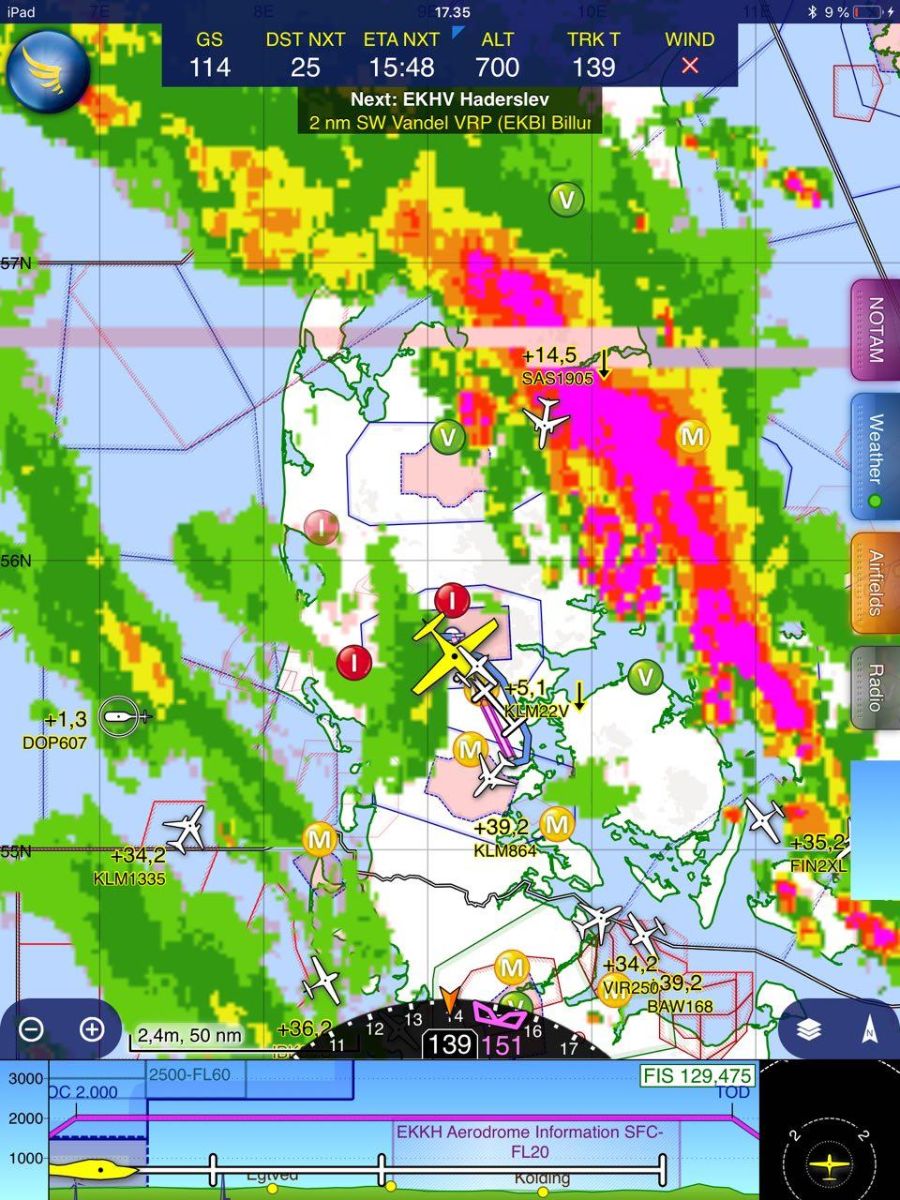https://www.motorflyvning.dk/uat

What can we do now and what are the perspectives?

AOPA has for a long time been working to improve access to weather and traffic data in the cockpit in Europe. In the US the groundbased UAT transmitters has for years been established across the continent and transmits not just weather and notams but also traffic information from ATC radars so that the pilot is able to see not just traffic that sends out an ADS-B signal, but also traffic with a conventional mode C or S transponder, socalled TIS-B. The overarching perspective is of course to improve flight safety by weather related accidents and to reduce the risk of mid-air collisions. A US study shows that the effect can be quite remarkable: the likelihood of a fatal accident decreased by 89 percent for aircraft using ADS-B In.
As we gain operational experience the plan is to supplement the current transmitter with 4-5 additional transmitters which should be enough to cover most of Denmark at altitudes from 5000ft and up. A similar trial is taking place in the UK and a transmitter has also been established temporarily in Friedrichafen in Germany. The hope is that all of Europe will eventually be covered as awareness and demand increases and receivers become more widespread.
Currently, the Danish transmitters are limited to sending out weather radar images, TAFs and Metars. We expect that Notams will be added soon. This becomes increasingly relevant with drone areas beeing established more frequently through Notam and in the short to medium term the technology therefore also has the potential to reduce conflicts between drones and manned aviation.
Eventually we would hope to be able to send out a live traffic feed of all traffic picked up by ATC radars like it is done in the US, but at this point this is still only a dream in Europe. With the existing setup pilots will only be able to see other traffic that sends out an ADS-B signal. Some receivers also allow to show FLARM signals typically emitted by gliders and some will show mode C and mode S transponder equipped aircraft as bearingless targets with an altitude indication.
The hope is that the benefits in the form of inflight traffic and weather data will make more aircraft owners see the benefits of ADS-B equipment and choose to install the equipment on a voluntary basis. The more aircraft are equipped the more complete is the traffic information provided and therefore the benefit of the equipment.
The installation cost of certified panel-mounted ADS-B in/out equipment is still considerable for GA. A UAT/ADS-B receiver however can be purchased at a modest cost of a few hundred Euros. In fact, one portable model on the market, the SkyEcho2, is not just a receiver but also includes a 20 Watt CAP 1391 compliant ADS-B transmitter that will send out the position of the aircraft so that the aircraft becomes visible for other traffic with an ADS-B receiver. As part of a comprehensive initiative to improve electronic conspicuity the UK CAA has permitted the use of the transmitter. It is currently not allowed to activate the transmitter in Denmark, so the unit must be configured in receive-only mode, but we hope that the Danish CAA will support a similar initiative in the interest of improving flight safety.
Which UAT receiver should you buy?
We refer to this excellent comparison of UAT receivers in the market. You can ignore comments about the Sirius-XM sattelite reception since this is not available in Europe.
Below you will find reports on receivers we have actually tested in Denmark.
Practical Experiences
Below we will report on practical experiences with UAT and ADS-B technology. The transmitters established in Billund and Roskilde are provided by Garmin and the signal should be compatible with all standards compliant UAT receivers on the market. In practice we have so far successfully tested the reception with the following receivers:
- Garmin GDL-39
- SkyEcho2 (EU customer should buy from here)
- Stratus3
- Sentry
- Garmin 1000
All devices are able to receive ADS-B traffic and UAT weather but each device has it particular additional benefits such as AHRS, CO detector, ADS-B transmitter etc. Some devices are limited to only work with certain apps. We hope to provide you all the details here as we progress with the testing.
What is the range?
The UAT signal is limited to line of sight and in practice our experience is that the reception range is a little shorter than for instance the distance where a VHF radio signal can be received. Maybe because the device used for the test was not linked to an external antenna.
So far we have made the following real life observations about the ability to receive UAT weather data from the Billund transmitter. In practice it is possible to pick up the signal well into Northern Germany from an altitude above 8000ft:
| Altitude | Distance from transmitter | Device |
| FL90 | 80NM | SkyEcho2 |
| 2500ft | 30NM | SkyEcho2 |
| 1500ft | 20NM | SkyEcho2 |
| Ground | <1NM – very sensitive to buildings | SkyEcho2 |
Voir encore
Wikipedia FR https://fr.wikipedia.org/wiki/Automatic_dependent_surveillance-broadcast
et notamment https://fr.wikipedia.org/wiki/Automatic_dependent_surveillance-broadcast#Syst%C3%A8mes_ADS-B et encore https://fr.wikipedia.org/wiki/Automatic_dependent_surveillance-broadcast#Applications